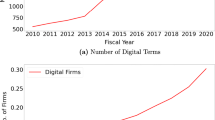Abstract
This study provides a test of dominant firm theory by examining earnings-induced information transfers within industries that have a dominant firm. Based on the economic asymmetries between dominant and fringe firms, it is posited that the earnings announcements of dominant firms will act as an “industry bell,” resulting in a positive association between the unexpected earnings of the dominant firm and the security price changes of the fringe firms. Due to their position as industry followers, the earnings announcements of the fringe firms are not expected to affect the security prices of the dominant firm. The results of empirical tests are generally consistent with dominant firm theory.
Similar content being viewed by others
References
Baginski, S., “Intraindustry Information Transfer Associated with Management Forcasts of Earnings.”Journal of Accounting Research 25, 196–216, (1987).
Bernard, V. and J. Thomas, “Evidence That Stock Prices Do Not Fully Reflect the Implications of Current Earnings for Future Earnings.”Journal of Accounting and Economics 13, 305–340, (1990).
Encaoua, D., Geroski, P., and A. Jacquemin. “Strategic Competition and the Persistence of Dominant Firms: A Survey.”New Developments in the Analysis of Market Structure, edited by J. Stiglitz and G. Mathewson, 55–89. Cambridge, MA: The MIT Press, 1986.
Foster, G., “Quarterly Accounting Data: Time Series Properties and Predictive-Ability Results.”The Accounting Review 52, 1–20, (1977).
Foster, G., “Intra-Industry Information Transfers Associated with Earnings Releases.”Journal of Accounting and Economics 3, 201–232, (1981).
Foster, G.,Financial Statement Analysis, 2nd Ed. Englewood Cliffs, NJ: Prentice-Hall, 1986.
Frost, C., “Intraindustry Information Transfer: An Analysis of Research Methods and Additional Evidence.”Review of Quantitative Finance and Accounting 5, 111–126, (1995).
Geroski, P. and A. Jacquemin, “Dominant Firms and Their Alleged Decline.”International Journal of Industrial Organization 2, 1–27, (1984).
Han, J., Wild, J., and K. Ramesh, “Managers Forecasts and Intra-Industry Information Transfers.”Journal of Accounting and Economics 11, 3–33, (1982).
Hanweck, G. and S. Rhoades, “Dominant Firms, ‘Deep Pockets,’ and Local Market Competition in Banking.”Journal of Economics and Business 36, 391–402, (1984).
Hilke, J. and P. Nelson, “Noisy Advertising and the Predation Rule in Antitrust Analysis.”Antitrust Policy and Strategic Behavior 74, 367–371, (1984).
Johnston, J.,Econometric Methods, 3rd Ed. New York: McGraw Hill, 1984.
McGee, J. and H. Thomas, “Strategic Groups: Theory, Research and Taxonomy.”Strategic Management Journal 7, 141–160, (1986).
Mixon, J. and N. Uri, “On the Optimal Pricing Policy of a Dominant Firm.”De Economist 134, 225–227, (1986).
Patell, J. and M. Wolfson, “The Intraday Speed of Adjustment of Stock Prices to Earnings and Dividend Announcements.”Journal of Financial Economics 13, 223–252, (1984).
Pownall, G. and G. Waymire, “Voluntary Disclosure Choice and Earnings Information Transfer.”Journal of Accounting Research—Supplement 27, 85–110, (1989).
Richards, D., “Wages and the Dominant Firm.”Journal of Labor Research 4, 177–182, (1983).
Roberts, M., “Testing Oligopolistic Behavior.”International Journal of Industrial Organization 2, 367–383, (1984).
Scherer, F.,Industrial Market Structure and Economic Performance. Chicago: Rand McNally, 1980.
Schipper, K., “Commentary on Information Transfers.”Accounting Horizons 4, 97–107, (1990).
Shepherd, W., “Assessing Predatory Actions by Market Shares and Selectivity.”The Antitrust Bulletin 31, 1–28, (1986).
Theil, H.,Principles of Econometrics. New York: John Wiley & Sons, Inc., 1971.
Watts, R. and J. Zimmerman,Positive Accounting Theory. Englewood Cliffs, NJ: Prentice Hall, 1986.
Zellner, A., “An Efficient Method of Estimating Seemingly Unrelated Regressions and Tests for Aggregation Bias.”Journal of American Statistical Association 57, 348–368, (1962).
Author information
Authors and Affiliations
Rights and permissions
About this article
Cite this article
Schoderbek, M.P. Theory of the dominant firm: A capital market test. Rev Quant Finan Acc 5, 253–270 (1995). https://doi.org/10.1007/BF01074841
Issue Date:
DOI: https://doi.org/10.1007/BF01074841




